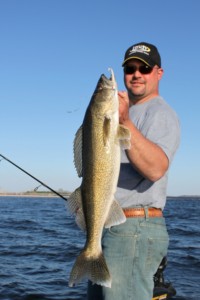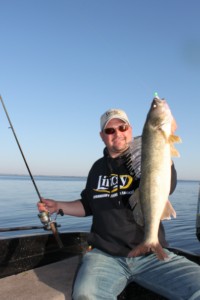Walleyes on Praire Lakes
Category: article
Apr 28th, 2011 by OutdoorsFIRST
Modified Apr 28th, 2011 at 12:00 AM
Jigs & Cranks for Prairie Lakes Walleyes
Casting a jig to the end of point that juts out along a cattail bank and feeling for that telltale thump, it almost doesn’t seem like you’re walleye fishing. Pick the right stretch of bank to pitch toward, though, and offer the correct bait, and the fish will soon confirm that walleyes are indeed the name of the game.
 |
|
| Jason Feldner |
Walleyes relate heavily to forage-filled shoreline cover in prairie lakes, and anglers who know how to pick their banks catch fish shallow throughout the seasons. Jason Feldner of Perch-Eyes Guide Service on North Dakota’s Devils Lake is one such angler. Although Feldner uses a variety of approaches to catch walleyes at different times, he spends significant time pitching X-Change Jigs and Shadling crankbaits from spring ice-out until he wraps up his open-water fishing late in the fall.
The fish are shallowest in the spring, largely because the sun adds a hint of warmth to big shallow flats, and Feldner will cast directly to the cattails. As the season progresses and the submerged cabbage starts to get thick, he’ll move the boat back into a little deeper water. He’ll parallel the same banks and cast toward them, throwing the same lures. He’ll simply adjust his path so he can fish the outside edge of the cabbage instead of the actual shoreline cover. Feldner also will fish around more flooded timber as the season progresses.
Zeroing In
Wind is a critical factor for finding the most active walleyes along the banks of a prairie lake. Feldner focuses almost exclusively on wind-beaten banks because the wind concentrates forage against those banks and creates sediment in the water, serving the double function of concentrate the walleyes and prompting them to feed more actively. “The wind is especially helpful when it blows in the same direction for four or five days,” Feldner said.
Along any given section of bank, the fish are most apt to be along the sides or ends of points, in little cuts in the cattails and near isolated bonus cover, such as trees or rockpiles, which complement the vegetation. Feldner will hit key features from multiple angles as he passes them and will always repeat casts that produce fish.
The fish typically reveal themselves pretty quickly if they are home, so if action doesn’t occur fairly quickly, Feldner often will move to another wind-beaten bank and continue his search.
1-2 Punch
Feldner’s lures of choice for this style of fishing are a Lindy Shadling and a Lindy X-Change Jig matched with some sort of plastic tail, and he almost always has both baits rigged. “Some days they want the crankbait. Other days they want the jig. You just have try both and see,” Feldner said.
The Size 5 Shadling, which is 2 1/16 inches long, is a very good size to match prevalent forage, and it runs to a good depth to kick the bottom some but not dredge it or get hung. It also has rattles, which Feldner considers very important, and it does not float back up quickly when he pauses his retrieve. Feldner also likes the Shadling’s realistic color schemes. A few of his favorite colors are Bluegill, Redtail and Shiner.
“They’re also tough” Feldner said about Shadlings, “and they all run true out of the package.”
Feldner’s baits definitely get “toughness tested,” especially during the spring, because Devils Lake supports a tremendous pike population, and during first part of the year the toothy northerns are thick among the walleyes and in full attack mode.
Feldner believes in varying presentations and letting the walleyes dictate their preferences. If he sees fish following his lure, but not quite committing to it, for example, he has found that speeding the retrieve suddenly often will trigger strikes. That said, pausing the presentation or mixing in erratic tugs sometime can have a similar effect. He experiments continually and pays close attention to when the fish bite.
 |
|
Feldner likes X-Change Jigs for pitching plastics because he can easily change head sizes when the volatile North Dakota wind kicks up or falls back. He favors the lightest jig that the wind allows him to get away with, but he needs to be able to reach bottom and to be able to feel jig very well at all times. His most common size is 1/8 ounce, but he’ll use the entire range of X-Change jig head sizes at times.
Feldner typically matches his jigs with 3- or 4-inch paddle-tailed grubs or minnow-shaped soft-plastic baits, having found that the walleyes usually like the thumping action of a paddle tail. However, on dead calm days, when the fish tend to be more skittish, he’ll opt for a narrow bait with a forked tail that glides through the water, making it a bit more subtle.
White is definitely Feldner’s color of choice for soft-plastic tails. Many of the lake’s forage species, which include shrimp, various minnows and the fry of white bass and other sport fish, flash quite a bit of white, so the fish relate white with food. He also likes Pearl White heads on his X-Change Jigs, but when the water is stained, a bright color like Chartreuse Glow or Hot Pink can draw more strikes.
An Alternative Approach
When the fish stack up in specific spots, whether around shoreline timber, off cattail points in bays or over offshore structure, Feldner will anchor and slip-bobber fish. He’ll anchor his boat upwind of the key area and fish leeches under Thill Pro Series Slip Floats, suspending his live offerings just off the bottom.
As the season progresses, Feldner will do more and more slip-bobber fishing, suspending his leeches over offshore humps. He emphasized, however, that there are always fish along the edges that can be caught with jigs and crankbaits.
Devils Lake
An expansive lake in North Dakota’s Prairie Potholes Region, Devils Lake supports a outstanding population of high-quality walleyes, with big numbers of pike and huge white bass adding fun to the fishing action.
It’s an unusual lake in the sense that its size is ever-changing, and in recent years it has been growing – overtaking roads and farms and threatening lakeside towns. The grid of sunken roads actually provides important fishing structure, but the same roads also cause significant navigational hazards, so spending a day or two with a guide on this lake is a very good idea. Devils Lake is also extremely popular with shoreline anglers, who tend to do very well catching all of the lake’s major sportfish species.
For more on Devils Lake, including fishing reports and information about guided fishing and lodging, visit percheyes.com or call (701) 351-1294.